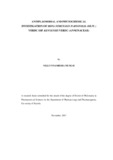| dc.contributor.author | Mungai, Nelly N | |
| dc.date.accessioned | 2016-04-28T15:03:11Z | |
| dc.date.available | 2016-04-28T15:03:11Z | |
| dc.date.issued | 2015 | |
| dc.identifier.uri | http://hdl.handle.net/11295/95318 | |
| dc.description.abstract | Attention has recently shifted to ethnopharmacological study of plants as sources of
alternative medicines. This approach has yielded clinically useful medicines
particularly for the treatment of malaria. Upon literature survey, plants belonging to
the Annonaceae family have been found to be widely used in traditional medicine
for the treatment of malaria. In Kenya, particularly in the coastal region,
Monanthotaxis parvifolia (Oliv.) ssp. kenyensis Verdc (Annonaceae) is used for the
treatment of malaria. The aim of the present study was to investigate the
antiplasmodial and phytochemical properties of this plant. This was in order to
establish its ethnopharmacological basis of its use in the treatment of malaria.
Materials and Methods
The authenticated plant material consisting of the twigs and leaves was collected
from Thika, Kenya. Preparation of the reagents and plant specimens for
macroscopic and microscopic study was carried out as per published protocols or
validated methods. Soxhlet extraction and bioassay-guided fractionation in
combination with chromatographic techniques were used for the extraction,
isolation and purification of the isolated compounds. Spectroscopic methods were
used to carry out structure elucidation of the isolated compounds. In vitro
antiplasmodial tests for both the crude extracts and phytochemical isolates were
carried out using the chloroquine-sensitive (D10) and chloroquine-resistant (Dd2)
Plasmodium falciparum strains. Cytotoxicity testing was done using Chinese
Hamster Ovarian (CHO) cells on active crude extracts and the phytochemical
isolates. Crude extract of Monanthotaxis parvifolia were also tested for glycaemic,
analgesic and antipyretic activities.
Results and Discussion
The antiplasmodial activity against the chloroquine-sensitive and chloroquineresistant
Plasmodium falciparum strain ranged from 5.58 to 38.07 μg/ml for the | en_US |
| dc.language.iso | en | en_US |
| dc.publisher | University of Nairobi | en_US |
| dc.title | Antiplasmodial and phytochemical investigation of monanthotaxis parvifolia (oliv.) verdc ssp. Kenyensis verdc (annonaceae) | en_US |
| dc.type | Thesis | en_US |
| dc.description.department | a
Department of Psychiatry, University of Nairobi, ; bDepartment of Mental Health, School of Medicine,
Moi University, Eldoret, Kenya | |

